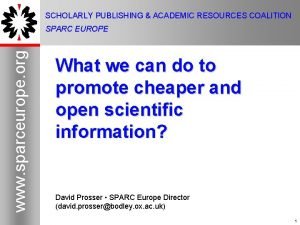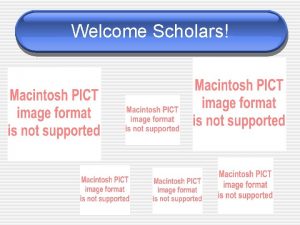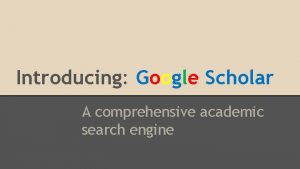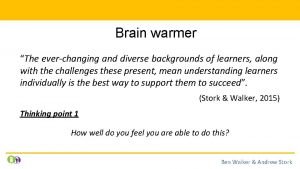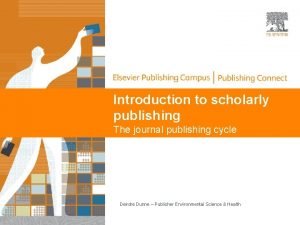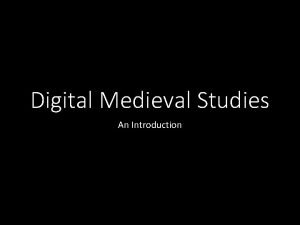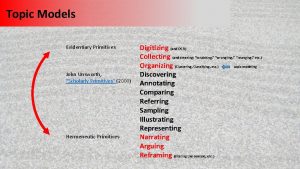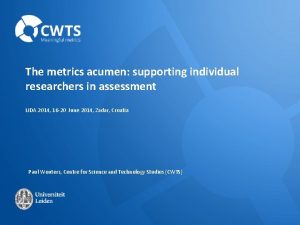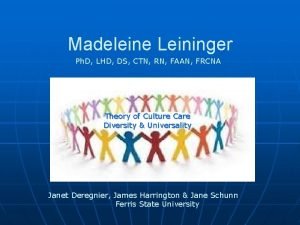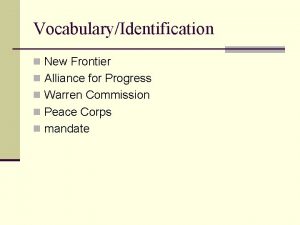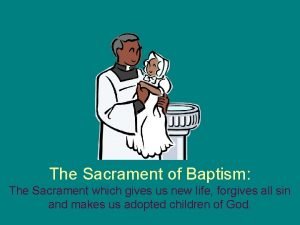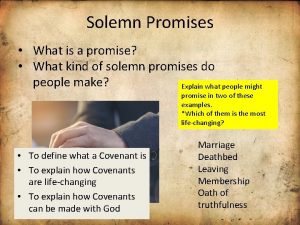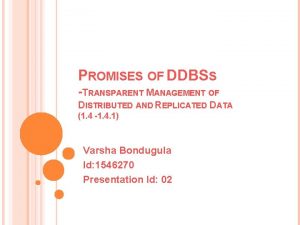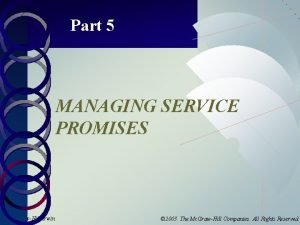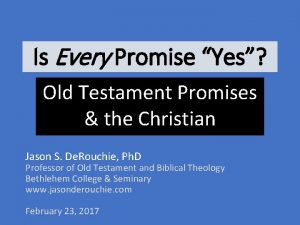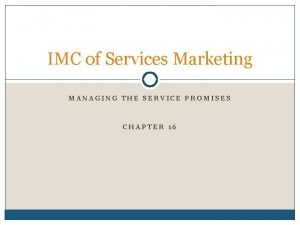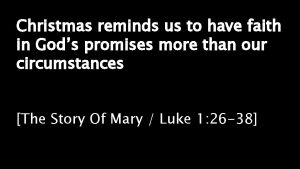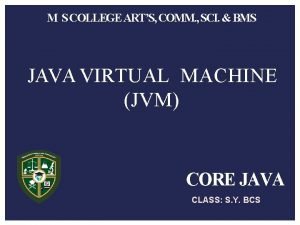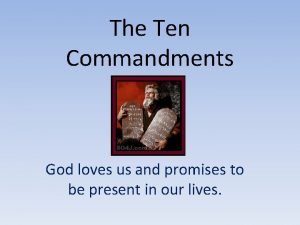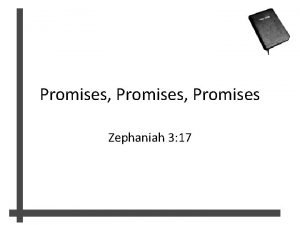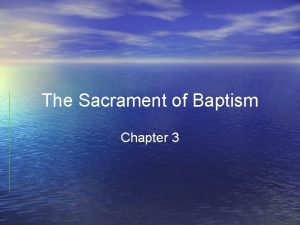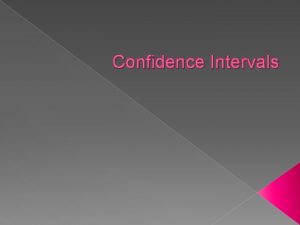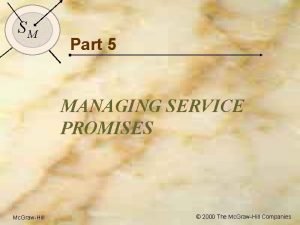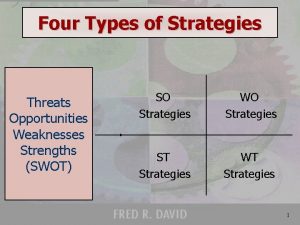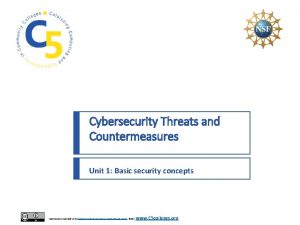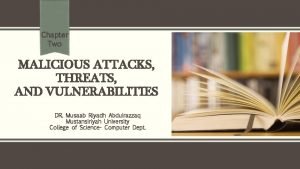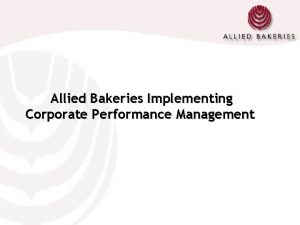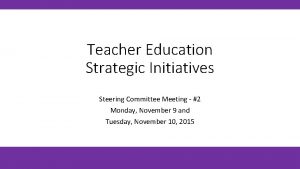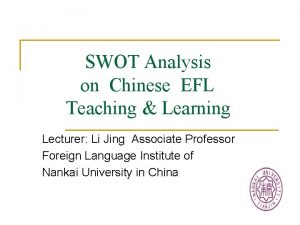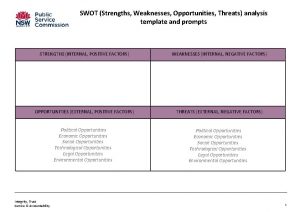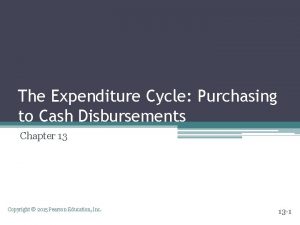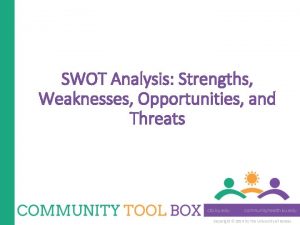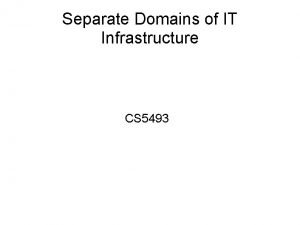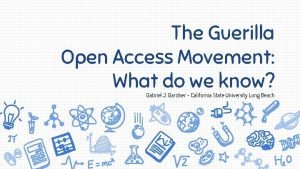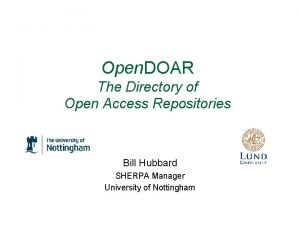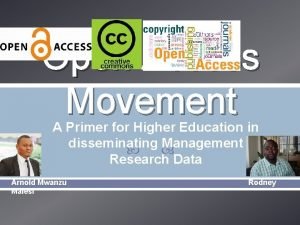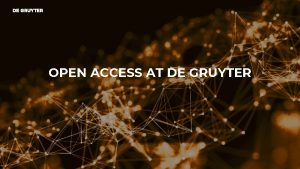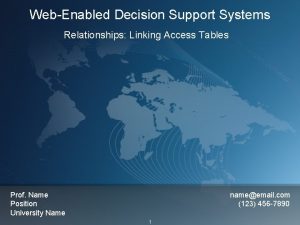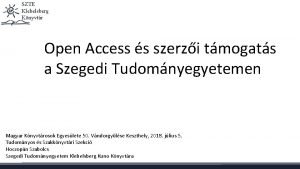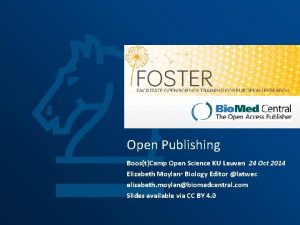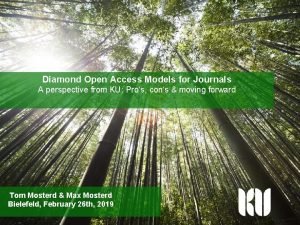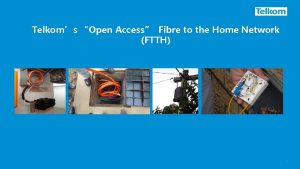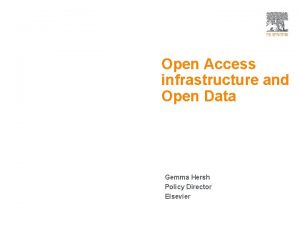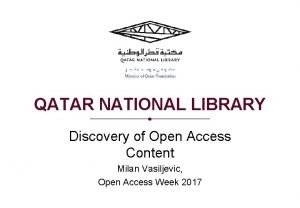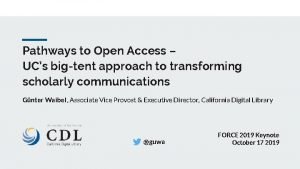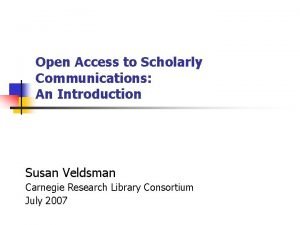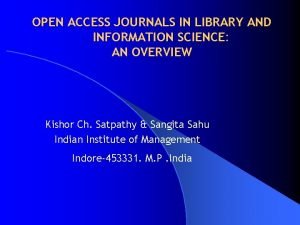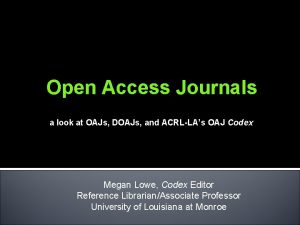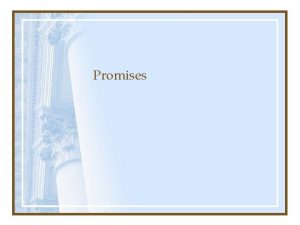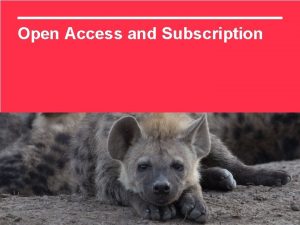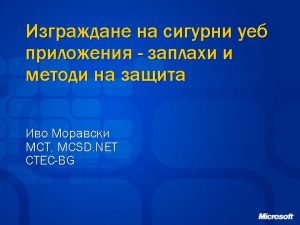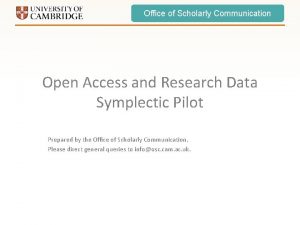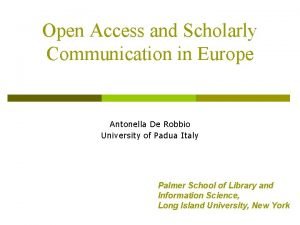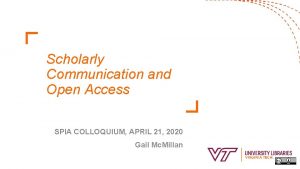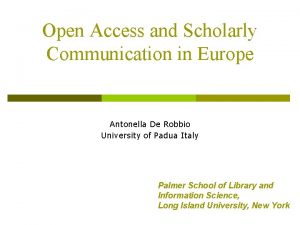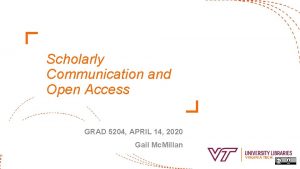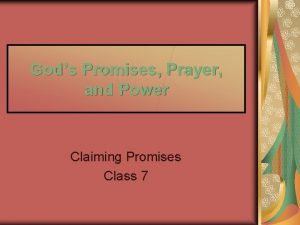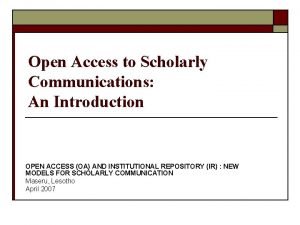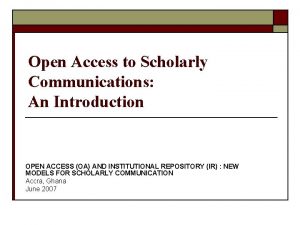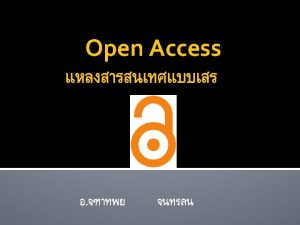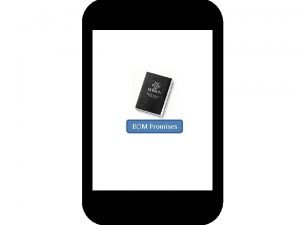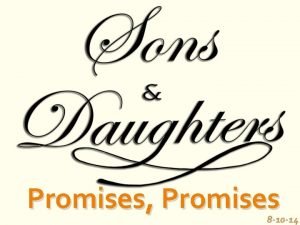Open Access Threats and Promises of Scholarly Communication



































































- Slides: 67

Open Access: Threats and Promises of Scholarly Communication Derek Whitehead April 2009

Outline 1) Introduction – Swinburne, Australia 2) Open access – many kinds 3) Open access and libraries 4) Repositories - what they are 5) Repositories and open access 6) What else can a repository do? 7) Making repositories work 2

1 Swinburne > Dual sector university – in Australia 13, 000 higher education students (EFTSU), 13, 000 TAFE (technical and further education) (FTE) > Rapid growth based on international students > Five campuses in Melbourne, one in Malaysia > Technological university – engineering, Information and communications technology, design, life and social sciences, business. 3

1 Swinburne 4

1 Swinburne Library, Swinburne Circus 5

Mission and values > a focus on the customer > collaboration and partnership > a commitment to staff learning, growing and being creative > the importance of information and knowledge in human society > an equitable approach to accessing information, *open processes, and > a commitment to be open and responsive to change. > a commitment to the library as an intrinsic part of and partner in the teaching, learning and research mission of the university. 6

ARROW and Swinburne’s Repository > Partner in the ARROW project from 2004 to 2008 > Funding from Australian Government – about $8 million > Led by Monash University, with three other partners – Swinburne, University of NSW, National Library of Australia > Developed repository software – VITAL – with VTLS, a US library software company > Swinburne repository is Swinburne Research Bank at http: //researchbank. swinburne. edu. au > Two other repositories using DSpace and Equella 7

Repositories in Australia > All universities must have a research repository > Repository provides access to the institution’s research for the research evaluation scheme ERA (Excellence in Research Australia) > There is Australian Government funding to assist – the ASHER program of over A$20 million > There is a strong preference for open access content > Multiple software – VITAL, e. Prints, DSpace, Equella, Fez, Digitool, more > I will refer to the Swinburne Model in this seminar 8

2 Open access and publishing 9

2 Open access and publishing § Scholarly publishing is in a dramatic transition phase § The scholarly journal – 24, 000 or more of them – has mainly moved from print to online in the past 10 -15 years. The body of material is still growing though. § The scholarly monograph is becoming less viable financially as print runs fall. Why? (a) affordability pressure as journals cost more, and (b) demand factors, (c) rise of ebooks. But still just as important. § Scholarly reference material is also moving online. 10

2 Publishing - what’s online? § Even more is moving online and it is often free: § Newspapers and news § Much government publishing is now online and mostly free § Much reference material is now online, free or not § Official information such as spatial information, statistical information, law and legislation, election results, and much more § Research is moving online § Some kinds of books are now online 11

2 Publishing - what’s not online? § What’s not online? § Magazines are not online § Textbooks are not online much – why? (a) the print business model is better; (b) a heavily-used book sometimes works better in print – i. e. demand factors. § Fine printing is not online § Monographs/books are not online until they have been around for a while § Journals where home subscribers dominate are not online § How does this affect price? 12

2 Open access and publishing § Open access means free online access for everyone § Closed access is access through some kind of barrier – usually based on price § Many kinds of open access – green and gold – Open courseware – Open access research publications – Research data – Open licensing – Images and other research materials – Out of copyright and online – is Google Books open access? 13

2 Open access and publishing § What does “published” mean? § It means different things / different purposes: § Copyright § Defamation § Academic publication § Stevan Harnad uses the term “accessed, read and used” § Can something be open access online and not published? § Are these published? an online Ph. D thesis? a child’s drawing on the classroom wall? this powerpoint? § We are all publishers now 14

2 Open access journals § Open access is about the coming of digital online § We have moved from print, to digital on CD, to digital online § Open access is about how we use it (access) and how we pay (affordability/business models) § Print was easy! § Open access means NO TOLL : no gateway, anyone can enter. § It does not mean free. But who pays? And how? 15

2 Open access journals – who pays? What is paid for? § Research and writing: this is usually made available to the publisher without charge. The author usually organises permissions too. § Refereeing and peer review: the same applies. § Editing is paid for by the publisher. § Printing and distribution is paid for by the publisher, e. g. the case of ALIA § Pricing is mainly legacy pricing at this stage § What are the real costs of online publishing? 16

2 Open access – economics > Professor John Houghton (Victoria University), Professor Charles Oppenheim (Loughborough) and others > Economic implications of alternative scholarly publishing models: exploring the costs and benefits: a report to the Joint Information Systems Committee (JISC), January 2009 > http: //www. jisc. ac. uk/publications/economicpu blishingmodelsfinalreport. aspx > Scholarly publishing cost UK higher education UK 5 billion per year > Open publishing models would save a great deal > Publishers reject the conclusions 17

2 Open access journals There are several kinds § Green: conventional publishing in journals, then self-archiving in repositories. Who pays? § Gold: the journal is open access. Who pays? There are different models. § Hybrid open access: the publisher agrees to make certain single articles OA on payment of an article processing charge § Institutional membership OA where an institution bulk buys the right to OA publication. § Acknowledgements: Richard Poynder, Stevan Harnad. 18

2 Open access journals Rapid growth § Directory of Open Access Journals (DOAJ) Lund University Libraries http: //www. doaj. org § 23, 300 peer-reviewed journals in Ulrichs § Elsevier, Springer, Taylor & Francis, Blackwell and Wiley (now merged) published 25% § About 4000 are open access § Half published in US and UK § See http: //poeticeconomics. blogspot. com/2009/03 /dramatic-growth-of-open-access-march-31. html 19

2 Open access journals Very high stakes § Concentration of the industry – Wiley and Blackwell merged most recently (2007) § Major STM publishers have over half the market, which was $9. 2 billion in 2005 § Reed-Elsevier: over 25% of world STM information § Thomson Reuters § Taylor & Francis § Springer § Wolters Kluwer (profit € 918 million in 2007) 20

2 Open access monographs New model, approaching fast § Decline of the scholarly monograph has been a long time coming § But the scholarly book remains extremely important § Now quite common – the book is online and open access (free) and you can buy a print-ondemand copy § University presses are adopting this model § Economics is the main driver – the buyer pays the full cost of printing, the university pays the cost of publishing 21

2 Open access science Science tends to be open § Many universities have now committed to open access to research outputs § e. g. MIT faculty § Grant the university nonexclusive permission to distribute their articles through DSpace § Have the right to use and share articles for any non-profit purpose § Similar policies at some schools at Harvard, Stanford 22

2 Some reports § The University’s role in the Dissemination of Research and Scholarship – a Call to Action. ARL, CNI, Association of American Universities. February 2009. § http: //www. arl. org/bm~doc/disseminatingresearch-feb 09. pdf § Focus on dissemination of new knowledge § Scepticism about the current publishing model § Focus on the university retaining control, not giving it away 23

2 Some more reports § The Research Library’s Role in Digital Repository Services: Final Report of the ARL Digital Repository Issues Task Force. January 2009. § http: //www. arl. org/bm~doc/disseminatingresearch-feb 09. pdf § Venturousaustralia: building strength in innovation. (The Cutler Report). Canberra, Department of Innovation, Industry, Science and Research, 2008. § http: //www. innovation. gov. au/innovationreview 24

2 New copyright models Open licences § The anomaly of open access and online is that 1) we could have new knowledge made immediately and cheaply available to all 2) But we have a traditional structure of statecreated monopoly (copyright) which creates artificial shortage when there is natural glut 3) The great advantage of the digital world is therefore resolutely opposed by the current system of scholarly publication § Does something have to give? Maybe. 25

2 New copyright models Open licences § Creative Commons are the best known open licence structure – see http: //www. creativecommons. org § The four licences are § § Attribution § Share alike § Noncommercial § No derivative works A large amount of material is being licenced this way 26

2 Open licensing 27

3 Open access and libraries 28

3 Open access and libraries § Libraries are supremely a mechanism for open access § They pay, you use § They apply skills, software and processes to organise their collections § They work with other libraries to maximise access for all § Libraries take pride in their openness – a core value and an organising principle § Digital libraries use the same skills and principles as book libraries 29

3 Open access and libraries § Digital libraries are where we are heading, and mostly open access. § They use these skills § Quality control § Version control § Comprehensiveness and completeness § Continuity § Vocabulary management § Standards § Pretty good. Better than Google. 30

3 Open access and libraries § Open access is where we are headed § It is a complicated world, and what libraries are working with now are discovery layers § How to find what you want without all the noise of a Google search. § How to integrate searching open access, open Web, and commercial access § How to organise information so that it can be found systematically § How to “publish” so that we can all use it 31

4 What is a repository? 32

A Repository is a way of organising things > Not really much like a backpack > More like a library > We hope > A repository ORGANISES and COMMUNICATES > For the researcher it should – SAVE TIME – PROMOTE YOUR ACHIEVEMENTS 33

. . . and make things VERY accessible > Like Google > Most repositories can be searched as full-text through standard general search services such as Google, > Google Scholar provides access to “academic” content. It is beginning to search repositories. > Open. DOAR provides a full-text search service 34

A repository can organise anything digital > Like the Mousebrain library > It organises segments of mouse brains > Just like a library would > http: //www. mbl. org 35

4 Repositories – what are they? http: //www. ecs. soton. ac. uk/people/harnad 36

4 Repositories – what are they? § Institutional location and focus § Focus on research outputs – theses, refereed articles, much more § Web visibility: easy access via the web to their full content. § Full text where possible. § Organised - structured information (metadata) about the documents, following the eprints. org standard § Managed over the longer term, including permanent locations § Swinburne approach is pragmatic, open, experimental, empirical and always RESEARCHERFOCUSED 37

4 Repositories – what are they? JISC’s view too: > “England Australia have accepted that voluntary faculty-initiated and faculty-performed self-archiving is not a viable model for institutional-repository population, and they are beginning to move on. ” > An IR must be part of “a systematic, broad-based, well-supported data-stewardship, scholarlycommunication, or digital-preservation program. ” > All about rights, workflows, advocacy, technical systems, worldwide information flow, policies, and more > See the JISC Repositories Support Project and the Australian CAIRSS Neil Jacobs, Amber Thomas and Andrew Mc. Gregor, “Institutional repositories in the UK: the JISC approach. Library trends 57(2) (Fall 2008) p. 124(18) 38

4 Repositories – what purposes? > There are many purposes – Open access to research for us to share and build on – Resource discovery – Dissemination of research widely – Research evaluation and assessment – Institutional and personal impact – Information asset management by institutions – Process improvements – store once, use many times 39

5 Repositories – plenty of rules 40

5 Repositories – open access rule 1 Rule 1 – Copyright still applies § Open access removes the price barrier: anyone can access § The content remains subject to copyright § There are limits on copying, re-use, transmission but fair use or fair dealing still applies § The open access evangelists distinguish between free and libre (“free” in French) § “Libre” removes some copyright barriers but not all – it means open licences such as Creative Commons licences 41

5 Repositories – open access rule 2 Rule 2 – What can be deposited? The options include § Publishers mostly permit open access but there are limits - SHERPA is a database of publisher policies – see http: //www. sherpa. ac. uk § Gold = open access journals § Green = you can archive pre-print and post-print and maybe the publisher’s version (the published PDF) § Blue = you can archive post-print (ie final draft postrefereeing) § Yellow = can archive pre-print (ie pre-refereeing) § White = no archiving 42

5 Repositories – more about rule 2 Definitions § Pre-print = the article before it has been peer-reviewed § Post-print = the article after it has been peer-reviewed but before it has been edited for publication § Publisher PDF = the version of the article as it appears in the published journal Limitations § Most publishers impose limits on what you can put on open access § We will look at these now § Publishers mostly permit open access sometimes. But they limit the circumstances 43

5 Repositories – open access rule 3 Rule 3 – Is there an embargo period? § Many publishers allow your article to be included in a repository § But they have an embargo period § E. g. the National Institutes of Health (US) has a maximum 12 month embargo § You can put something into a repository any time, but not expose it until the embargo has expired 44

5 Repositories – open access rule 4 Rule 4 – What content in a repository? Repositories of research outputs may include a wide range § Books are not usually included – but there is a new trend § Theses § Conference papers & presentations – powerpoint, audio, video § Metadata § Book chapters § Digitised material § Research data 45

5 Repositories – open access rule 5 Rule 5 – Permission is always necessary § Some permissions are stated as policies – summarised in SHERPA and publishers’ websites § In the US federal regulations provide permission § If the author retains copyright, the author can provide permission § If the publisher owns copyright, you can seek it from them – with small publishers, this is a good way to go § A new strategy is to EDUCATE AUTHORS about the importance of retaining some rights 46

5 Repositories – open access rule 6 Rule 6 – You can pay for open access § Some publishers now permit open access for a fee § And some open access journals rely on author fees § Should the library pay the fee? 47

6 What Else Can a Repository Do? 48

6 What Else Can a Repository Do? Some examples from Swinburne. The repository includes records for all publications and full text for some. A repository can do lots of things including these: § Data management § Publishing § Integrating workflows § Promoting researchers § Mandates? 49

6. 1 Data management > Swinburne conducted a survey of researcher data practices in 2007 – conducted by Dana Mc. Kay > In 2009 joint project of the library and Swinburne Research to develop a project plan for data management – by June 2009. Key inputs: – survey – models developed at other institution – imperatives from funding bodies 50

6. 2 Publishing > Online journals using OJS. See the e. Journal of Applied Psychology at http: //ojs. lib. swin. edu. au/index. php/ejap ARROW Project 2005 > Online conferences using OCS. We are piloting the Cumulus conference http: //cumulus 09. com/ in November. > Online monographs using OMS? Under discussion with the Faculty of Design and print on demand players. Looking for partners in a collaborative efforts. > Presentations by Teula Morgan at PKP Scholarly Publishing Conference http: //ocs. sfu. ca/pkp 2007/viewabstract. php? id=44 > At Swinburne, Teula Morgan and Helen Wolff have established and developed this service. 51

6. 3 Integrating workflows, saving time § ARROW project established HERDC Working Group in Jan 2008 § Final Report late 2008 is at http: //www. arrow. edu. au/docs § Workflow § Input to repository, transfer to research management system, output to HERDC § Ensures repository holds records for 100% of HERDC publications § Model relates to § The organisation § The collection process § The data – e. g. quality control, who inputs, metadata, timing § Collection and storage of evidence § The software 52

6. 4 Researcher profiles > Project funded by ARROW in 2007 > Purpose was to explore the use of the repository as a source of data for other university systems > Creates online profile pages for Swinburne researchers with all data drawn from existing sources > Prototype drawing on repository, identity management, staff directory and research management systems 53

6. 4 Researcher profiles > Next stage: – Add to functionality including FOR (field of research) codes, grant information, researcher log-in process, ERA value – Go live with system in May – Enhance with data not currently in university systems > Marketing Department is an enthusiastic partner with the librafry and Swinburne Research 54

6. 5 Mandates? > Mandating has been achieved at many institutions > Mandating is complex – you can’t mandate deposit or everything > If you do, you can’t mandate that it goes on open access > The best mandates are administrative, embedded in processes – e. g. HERDC, theses > The time-saver mandate – “Save me time” – mandating MUST achieve a clear benefit for researchers 55

7 Making repositories work > Widen the scope > Sharing infrastructure – CAIRSS in Australia > Metadata – who does it and how? > Content recruitment approaches > Use and non-use > Copyright > Librarians, of course 56

7. 2 Sharing infrastructure > CAIRSS = CAUL Australia Institutional Repository Support Service – cost about $350, 000 per year > http: //www. caul. edu. au/cairss/ > Similar body in the UK – is the Repositories Support Project at http: //www. rsp. ac. uk – a huge amount of information, most recently a suite of podcasts > Swinburne provides copyright support as part of CAIRSS 57

7. 3 Metadata – names in context §> Nic. Names Project funded by ARROW 2008 -09 – objective is to “develop a practical toolkit to manage author names in a repository that will assist the effective identification, disambiguation, matching and display of names. ” §> November 2008 to June 2009 §> http: //nicnamesproject. blogspot. com/ §> Links to People Australia (NLA), and work by NISO, JISC, Thomson (Web of Knowledge), Elsevier (Scopus) and others. §> Both Thomson and Elsevier are developing unique researcher ID systems > “Names touch everything” http: //hangingtogether. org/? p=561 58

7. 3 Metadata – names in context § Rebecca suggests in the project blog that “The trouble with names is they belong to people. ” § What is wrong with the term “name authority control”? § Traditional cataloguing standards are designed by librarians for librarians - Name authorities are not just for librarians – names make a difference § The DIY approach originally intended for repositories may compound the problem of managing author names – see http: //www. eprints. org/openaccess/selffaq/ § Neither does the “take no prisoners” conventional library approach 59

7. 3 Metadata – names in context § Some issues: – library systems are more concerned with stock inventory than resource discovery – authors have no input in the way their works are represented – cataloguing standards treat them as just another piece of descriptive metadata – Academics use different forms of their names for specific purposes – There is no standard numbering system for people – there is, but privacy pendants won’t let us use it – Institutions have names, too 60

7. 4 Content recruitment § How do you get content into the repository? § Self deposit by the author § But incentives may be too low, and barriers too high § OR deposit by repository staff § All about workflows? § Add a record and revise it later § Provide open access to the text if possible § Seek a copy from the author 61

7. 4 Content recruitment § These are new skills in librarianship § Institutional repositories are still developing – after only five years – a sense of how they should work §Where repositories fit into a library is still not clear – even in Australia where every library has one §At Swinburne we use a customer relations management system §We accept that Swinburne Research Bank is a service we offer to academic staff §Repository staff need to be both proactive and responsive to real needs 62

7. 6 Copyright § Authors have a wide range of rights in most contracts § Provide copies to colleagues (100%) § Incorporate into other works (90%) § Post to personal / dept website (85%) § Post to repository (75%) § Use in course packs (95%) § See Sally Morris, Journal authors’ rights: perception and reality. London, Publishing Research Consortium, 2009. PRC Summary Paper 5. 63

7. 7 Librarians § SHERPA has an outline of the skill set required for an institutional repository manager / administrator – a super hero more than librarian § Five pages all about § Software (Unix, Linux, SQL Server, My. SQL, XML, PHP, JAVA, PERL) § Metadata skills § Data storage § Content including intellectual property skills § Liaison, advocacy, training and support, management § You need one of them. More than one. Many more. 64

A Short Conclusion Scholarly communication more than ever needs the library § The skills and knowledge of libraries are needed more than ever to organise the confusing scholarly communication universe. § The future library will manage the online scholarly world § Open access is part of the picture, price is part of the picture – this will not change tomorrow § Free does not mean DIY – it is too complicated § Libraries are entering the world of publishing and becoming skilled and important players. 65

Someone has to make sense of it all 66

Thank you Derek Whitehead Director, Information Resources and University Copyright Officer, Swinburne University of Technology Chair, Australian Digital Alliance President, Australian Library and Information Association dwhitehead@swin. edu. au 67
 Scholarly publishing and academic resources coalition
Scholarly publishing and academic resources coalition 영국 beis
영국 beis Scholarly habits
Scholarly habits Google scholar owner
Google scholar owner Scholarly tutoring
Scholarly tutoring Project management scholarly articles
Project management scholarly articles Scholarly articles
Scholarly articles Scholarly
Scholarly Scholarly primitives
Scholarly primitives Scholarly acumen
Scholarly acumen Madeleine leininger scholarly articles
Madeleine leininger scholarly articles Csun scholarly articles
Csun scholarly articles Communication channel threats
Communication channel threats The new frontier fulfilled promises
The new frontier fulfilled promises Baptismal promises
Baptismal promises If you made a formal solemn promise you
If you made a formal solemn promise you Promises of ddbss
Promises of ddbss Managing service promises
Managing service promises Old testament promises
Old testament promises Managing service promises
Managing service promises Possible levels of customer expectations
Possible levels of customer expectations Believing in god's promises
Believing in god's promises Faraj promises
Faraj promises Abby garfield
Abby garfield Security promises of the jvm
Security promises of the jvm Notes receivable amortization table
Notes receivable amortization table Conditional promises of god
Conditional promises of god Distributed database
Distributed database The one who reigns forever he is a friend of mine
The one who reigns forever he is a friend of mine First i must honor god second honor his name
First i must honor god second honor his name Zephaniah 3:1-20
Zephaniah 3:1-20 God's promises
God's promises Pompa diaboli
Pompa diaboli A catalog sales company promises to deliver
A catalog sales company promises to deliver Managing service promises
Managing service promises Terminal access controller access-control system
Terminal access controller access-control system Terminal access controller access-control system
Terminal access controller access-control system Wireless security threats and vulnerabilities
Wireless security threats and vulnerabilities So wo st wt
So wo st wt Cyber security threats and countermeasures
Cyber security threats and countermeasures Malicious attacks threats and vulnerabilities
Malicious attacks threats and vulnerabilities Opportunities and threats of a bakery
Opportunities and threats of a bakery Swot analysis of a teacher
Swot analysis of a teacher Swot analysis for english students
Swot analysis for english students The opportunities and challenges of media and information
The opportunities and challenges of media and information Strengths opportunities threats weaknesses
Strengths opportunities threats weaknesses Virus and related threats
Virus and related threats 4 basic expenditure cycle activities
4 basic expenditure cycle activities Opportunity and threat
Opportunity and threat Example of opportunities in school
Example of opportunities in school Workstation domain risks threats and vulnerabilities
Workstation domain risks threats and vulnerabilities Sci hub
Sci hub Doar open access
Doar open access Green gold open access
Green gold open access Degruyter open access
Degruyter open access How to open relationships window in access
How to open relationships window in access Szte repozitórium
Szte repozitórium Ku leuven open access
Ku leuven open access Ubb telecom
Ubb telecom Diamond open access
Diamond open access Open access fibre network
Open access fibre network Sqa solar open access
Sqa solar open access Open access infrastructure
Open access infrastructure Qatar national library open access
Qatar national library open access Open access library
Open access library Open access library
Open access library Open access library
Open access library Oajs
Oajs
